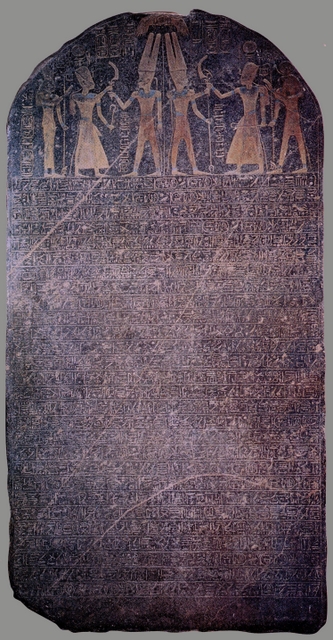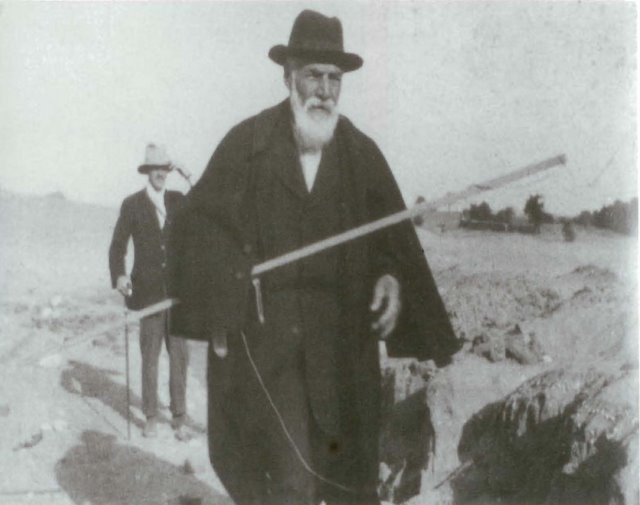Stelae and Reliefs of Pharaoh Merneptah, c. 1207 BCE
“Israel is wasted, bare of seed” – Merneptah Stele
“Your name shall no longer be Jacob, but Israel, for you have striven with beings divine and human, and have prevailed.” (Genesis 32-29)
Date- c. 1207 BCE
Current Location- Cairo Museum, Cairo, Egypt
Language and Script- Middle (Classical) Egyptian; hieroglyphic
Merneptah Stele Full View
General Information-
• After waging a campaign against neighboring states, ancient rulers would often erect stelae, or commemorative monuments, in the towns they conquered or in their capital cities. An example of this is the Merneptah Stele. Merneptah ruled Egypt ca. 1212–1202 BCE, succeeding his father Ramesses II (the Great). The Ramesside Dynasties (19th and 20th by Manetho’s count), to which Merneptah belonged, reinvigorated the New Kingdom by making grandiose territorial expansions. To secure their economic role in trade with Syro-Palestine and Mesopotamia, if not to simply spread their dominion and power, the Ramesside Pharaohs pushed northward along the Via Maris, conquering the Canaanite towns that guarded the route.
• Merneptah, having repulsed an invasion by the Libyans in the 5th year of his reign and after successful advances into the Levant, commemorated the victories with multiple stelae. This black granite example, measuring 7.5 feet in height, was found in Thebes, an Egyptian religious center. Merneptah’s inscription is written on the reverse side from an inscription by one of his predecessors, Amenhotep III. At the top of the stele is a small relief, or lunette, that still has its original coloring of yellow, red, and blue. It depicts the Theban Triad of most powerful gods- Amun is giving a sword to Merneptah, with Mut, Amun’s consort, and Khonsu, their son, in attendance. The inscription underneath contains a long hymn praising Merneptah’s power and retelling his subjugation of the Libyans and concludes with a brief poem recounting how he had subdued Egypt’s neighbors to the northeast, including Israel. A poorly preserved duplicate stele was discovered in a different part of the temple.
Relevance to Ancient Israel-
• This stele is sometimes called the “Israel Stele” because it contains the earliest extra-biblical reference to Israel as a people. Since the Pharaoh of the Exodus has often been identified with Ramesses II, Merneptah was his successor, and because the stele names the people of Israel in the land of Canaan, the stele corroborates the biblical timeframe of the Israelite Settlement.
• In terms of historical reliability, this stele is an excellent example of one type of New Kingdom monumental public record–the triumphal hymn inscription—and leaves no doubt as to the veracity of the non-supernatural information presented in it. As for the word ‘Israel,’ although there have been arguments to the contrary, the reading is virtually certain. First, it is the simplest reading of the hieroglyphic characters. Second, throughout the inscription, the scribe marked non-personal proper names (including the well-known Biblical sites of Ashkelon and Gezer) as place-names, but he marked only Israel as an ethnic group. The ‘marker’ is a special character added at the end of the word, known as a determinative, or a semantic category marker. Though they have no phonological value (they aren’t pronounced), determinatives are commonly used in Egyptian hieroglyphic script after nouns to help the reader quickly establish the meaning of that word. Although determinatives were not completely standardized, the contrast between the determinative used for “Israel” and those used for the city names makes it almost certain that Israel was considered a people.
• In addition to the word “Israel,” the phrase that follows, “Israel is wasted, its grain is not,” is important in fully understanding what the scribe thought of Israel. In Egyptian military descriptions, “its grain is not” is a frequently used description of conquered places and seems to refer to the common ancient practice of the victorious army ruining the crops and food storage of the conquered people, along with taking whatever provisions it needed. Coupled with the use of the determinative, we gain a picture of Ancient Israel as a settled, agricultural community in the hill territory of Palestine that did not yet have any major city centers at the end of the 13th century BCE. This is consistent with what we find in the Bible.
Circumstances of Discovery and Acquisition- The stele was discovered along the southern wall of the first courtyard in the mortuary temple of Pharaoh Merneptah in Thebes in 1896 by Sir Flinders Petrie. After the stele was read, Petrie keenly observed, “This stele will be better known in the world than anything else I have found.” The duplicate stele was left in place in the temple at Karnak. It lies near where it originally stood in the Cours de la Cachette, or Court of the Hiding Places, next to an inscription on the wall describing Merneptah’s battle against the Libyans and Sea Peoples. The outer western wall is covered with reliefs of 19th dynasty Egyptian battle scenes, some of which have been identified as possibly Merneptah’s.






